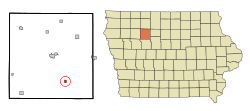Palmer, Iowa facts for kids
Quick facts for kids
Palmer, Iowa
|
|
|---|---|

Location of Palmer, Iowa
|
|
| Country | |
| State | |
| County | Pocahontas |
| Area | |
| • Total | 0.42 sq mi (1.10 km2) |
| • Land | 0.42 sq mi (1.10 km2) |
| • Water | 0.00 sq mi (0.00 km2) |
| Elevation | 1,240 ft (378 m) |
| Population
(2020)
|
|
| • Total | 138 |
| • Density | 326.24/sq mi (125.91/km2) |
| Time zone | UTC-6 (Central (CST)) |
| • Summer (DST) | UTC-5 (CDT) |
| ZIP code |
50571
|
| Area code(s) | 712 |
| FIPS code | 19-61050 |
| GNIS feature ID | 0459998 |
Palmer is a city in Pocahontas County, Iowa, United States. The population was 138 at the time of the 2020 census.
History
Palmer got its start in the year 1899, following construction of the Rock Island railroad through that territory.
Geography
Palmer is located at 42°37′51″N 94°36′0″W / 42.63083°N 94.60000°W (42.630929, -94.599948).
According to the United States Census Bureau, the city has a total area of 0.42 square miles (1.09 km2), all of it land.
Palmer lies near the center of Manson crater, an impact structure buried by glacial till and outwash.
Demographics
| Historical populations | ||
|---|---|---|
| Year | Pop. | ±% |
| 1910 | 177 | — |
| 1920 | 282 | +59.3% |
| 1930 | 297 | +5.3% |
| 1940 | 305 | +2.7% |
| 1950 | 296 | −3.0% |
| 1960 | 271 | −8.4% |
| 1970 | 264 | −2.6% |
| 1980 | 288 | +9.1% |
| 1990 | 230 | −20.1% |
| 2000 | 214 | −7.0% |
| 2010 | 165 | −22.9% |
| 2020 | 138 | −16.4% |
| Source: and Iowa Data Center Source: |
||
2020 census
As of the census of 2020, there were 138 people, 70 households, and 39 families residing in the city. The population density was 326.1 inhabitants per square mile (125.9/km2). There were 97 housing units at an average density of 229.2 per square mile (88.5/km2). The racial makeup of the city was 93.5% White, 0.0% Black or African American, 0.0% Native American, 0.0% Asian, 0.0% Pacific Islander, 4.3% from other races and 2.2% from two or more races. Hispanic or Latino persons of any race comprised 4.3% of the population.
Of the 70 households, 22.9% of which had children under the age of 18 living with them, 42.9% were married couples living together, 1.4% were cohabitating couples, 22.9% had a female householder with no spouse or partner present and 32.9% had a male householder with no spouse or partner present. 44.3% of all households were non-families. 41.4% of all households were made up of individuals, 22.9% had someone living alone who was 65 years old or older.
The median age in the city was 48.5 years. 21.7% of the residents were under the age of 20; 2.2% were between the ages of 20 and 24; 23.2% were from 25 and 44; 23.2% were from 45 and 64; and 29.7% were 65 years of age or older. The gender makeup of the city was 51.4% male and 48.6% female.
2010 census
As of the census of 2010, there were 165 people, 85 households, and 40 families residing in the city. The population density was 392.9 inhabitants per square mile (151.7/km2). There were 102 housing units at an average density of 242.9 per square mile (93.8/km2). The racial makeup of the city was 95.8% White, 0.6% African American, 1.2% Native American, 1.2% from other races, and 1.2% from two or more races. Hispanic or Latino of any race were 1.2% of the population.
There were 85 households, of which 18.8% had children under the age of 18 living with them, 36.5% were married couples living together, 5.9% had a female householder with no husband present, 4.7% had a male householder with no wife present, and 52.9% were non-families. 43.5% of all households were made up of individuals, and 17.6% had someone living alone who was 65 years of age or older. The average household size was 1.94 and the average family size was 2.63.
The median age in the city was 47.8 years. 18.2% of residents were under the age of 18; 6.6% were between the ages of 18 and 24; 20.6% were from 25 to 44; 35.2% were from 45 to 64; and 19.4% were 65 years of age or older. The gender makeup of the city was 50.3% male and 49.7% female.
Education
Pocahontas Area Community School District operates public schools. It was in the Palmer School District until July 1, 1993, when it consolidated into the Pomeroy–Palmer Community School District; on July 1, 2012, that district consolidated into the Pocahontas Area School District.
Sports
Palmer had many successful semi-pro baseball teams in the heyday of town teams.
Palmer's high school boys' basketball team had a long run of success in the 1980s, winning three straight state championships from 1986 to 1988. Its teams scored record numbers of points, and its games were played in front of packed crowds. Ultimately, the team won 103 straight games, setting the state record.
See also
 In Spanish: Palmer (Iowa) para niños
In Spanish: Palmer (Iowa) para niños

